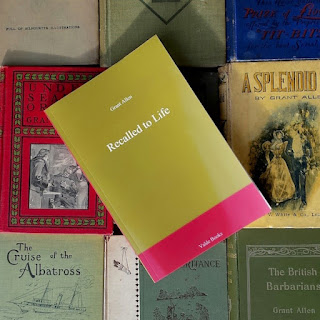Grant Allen
n.p.: Velde, 2009
Una Callingham remembers nothing before the death of her father – and that she remembers with great clarity. A flash of light revealed his bloodied body dead the floor and the back of another man escaping through an open window. The shock of it all rendered Una an amnesiac, famous throughout Victorian England as the one person who might be able to bring the killer to justice. The poor girl's condition was so severe that she was reduced to something akin to infancy. Una must again learn to speak, dress and, one presumes, use the water closet. After four years of seclusion and instruction, she emerges, aged twenty-two, as an inquisitive and highly intelligent woman who is intent on solving the murder of her father.
Recalled to Life is one of Allen's more commercial endeavours; he would've told his friends to give it a pass, but I'll not give the same advice. An entertaining novella, it touches upon the scientific advancements that consumed much of the author's non-fiction. For example, Una's father was working on a camera that takes photographs in rapid succession, much like real-life murderer Eadweard Muybridge. In fact, one of these photographs shows the very scene the poor girl remembers, but from a different angle. It's a remarkable piece of evidence, one that confirms Una's earliest memory.
What so attracted me to Recalled to Life – when I still haven't read The Woman Who Did – is that Una's investigations lead to Canada. In fact, the latter half takes place in the Dominion, then not three decades old, as Una tracks the man she believes to be her father's killer to British Columbia. It is the weaker half, and flirts with melodrama at the end, yet I admit to having been taken by surprise when the murderer is revealed.
Could be that I'm not much of a detective.
Allen isn't exactly remembered as a mystery writer, but the intricacy of his plots and his talent for creating interesting, often quirky characters are just the thing one wants in the genre. Shame he didn't do more... I write of a man who published 51 books in his fifty-one years.
Favourite passage:
"Canada!" Minnie exclaimed, alarmed. "You 're not really going to Canada! Oh, Una, you're joking!"Trivia: After What's Bred in the Bone, Recalled to Life is the second Allen I've read to feature a railway accident, and the third in which the railway influences the plot (see: Michael's Crag).
Object and Access: A 127-page trade-size paperback with blindingly white paper, my copy is one of two print-on-demand books in my collection. Coincidentally, the other is Allen's Michael's Crag, the work of Whiskey Priest and Caustic Cover Critic JRSM.
Valde Books can't compare. I bought it for the sole reason that in five years of hunting I'd never seen a copy for sale or auction. It's a sad fact that Recalled to Life was not terribly successful. It was first published in 1891 by J.W. Arrowsmith of Bristol, a house Allen biographer Peter
Morton informs had "a surprising reputation for detecting potential best-sellers: the Grossmiths, Chesterton, Jerome and Edgar Wallace all appeared under its imprint." Sadly, with Recalled to Life Allen didn't join their ranks. The only other English-language edition came from Henry Holt in New York (above), though it has been translated into Swedish (Återkallad till livet, 1911) and Finnish (Elämään palautunut, 1920). Not one copy of any edition is listed for sale online.
English-language editions are held by the Kingston Frontenac Public Library and ten of our universities. Library and Archives Canada fails miserably.
The first edition can be read online here – gratis – courtesy of the Internet Archive.
Related posts:












































